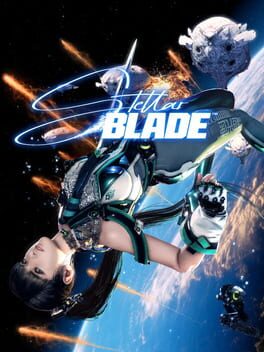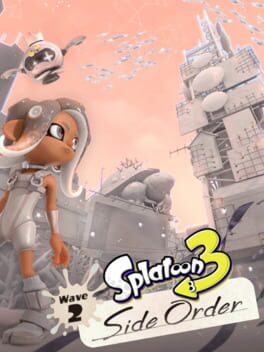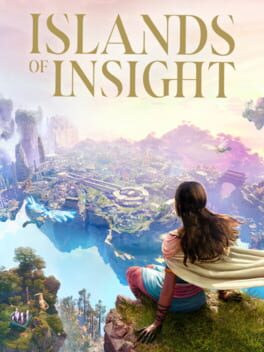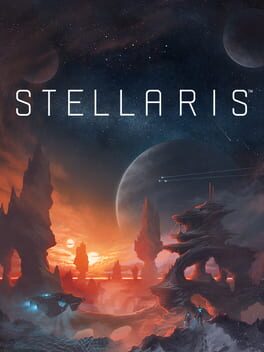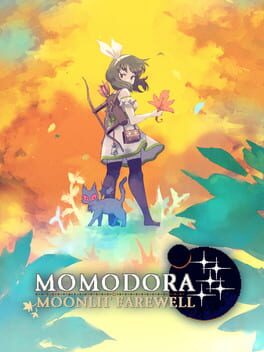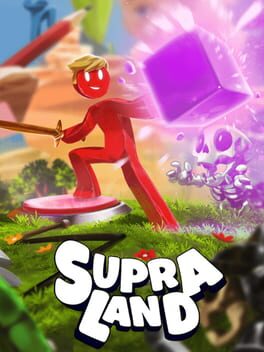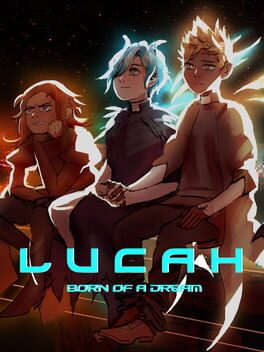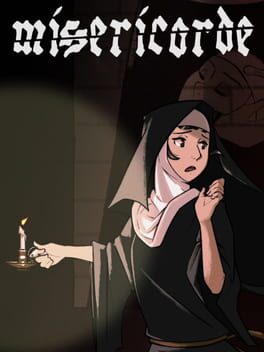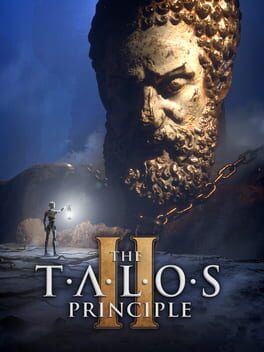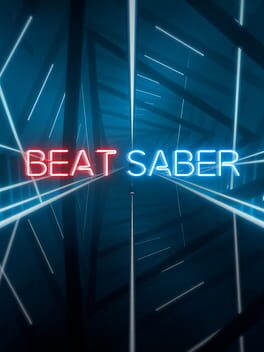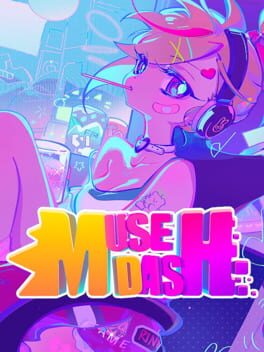SpaceAttorney
I've bought enough new games over the past few weeks that it would have taken a lot for me to stomach adding another title to the pile. Or so I thought, until the soundtrack for this popped up in my YouTube Music recommendations and I found out that it was the next game from the Sayonara Wild Hearts team. I mean, what was I going to do? Listen to it without getting the proper context first?
So I ended up going into this totally blind, and it's a trip. The game cold opens on your character standing next to a car with nothing to orient yourself beyond the objective "meet him at the hotel". The controls are minimalist as they come - directional movement plus one contextual "interact" action that's mapped to every button - which means the game doesn't even need to give you the familiarity of throwing up those familiar button prompts. It's an intimidating start, and kicks off a vibe of unfamiliarity that persists through the whole game, but beneath that feeling the puzzle design is actually quite forgiving. Both the puzzles and the information you need to solve them is pretty clearly signposted, so even if you haven't figured out how to manipulate that information to get an answer yet, it never feels like you might be missing something.
I've seen other reviews treat Lorelei as a sort of "meta" puzzle game, in the vein of recent hits Void Stranger or Animal Well, and although the surreal presentation and frequent use of mixed-media sequences lend themselves to that impression, I think fundamentally it's a much more traditional style of puzzle game. I've also seen people liken it to the puzzle sections of classic survival horror games, and while that's not wrong (there are a few sections that make this influence quite obvious) the lack of combat and horror make the sentiment kind of misleading. Personally, I'd describe it as something more akin to room escape games from the Flash game era, or maybe Safecracker (does anyone else remember Safecracker?). Just with more substance, and a heck of a lot more style. The game is also a lot more convenient with its storage of information than its presentation might lead you to believe, although I'd definitely still echo its recommendation to keep a physical notebook handy.
A lot of factors go into making the puzzles in Lorelei feel special, though. The hotel that serves as the setting has a great sense of place to it: rooms like the library and the art gallery are densely packed with puzzles and information in a way that other rooms aren't, simply because it would make sense for a real person to organize things that way. That choice lends itself to a weird kind of pacing, where the player often receives huge bursts of information at once, and it can feel overwhelming to try and keep track of it all. But the setting is small and dense enough that you don't really have to; you can just meander in any direction and you'll probably make progress somewhere before too long. Additionally, the puzzles are all deeply intertwined with the setting, characters, and story. This contributes to the initial feeling of confusion when you first start, since even the most basic details about what you're doing are used as puzzle elements, but it also means that you'll be paying attention to and piecing together the story naturally as you work your way through the puzzles.
Mechanically, there are some very interesting vectors by which puzzles are presented and solved which I won't spoil, but the vast majority of your time will be spent finding codes to open locks. This could easily get tiresome, but Lorelei puts in the work to make even opening locks feel good by providing a wide variety of lock types and giving each one a nice tactile feel despite the simplified control scheme. I do wish the dedication to minimalism hadn't spread to the UI, though, as you'll be referencing your handy photographic memory a lot and without a dedicated "back" button it takes as long to navigate back out of a particular file as it does to navigate into it.
If you know Simogo's previous work, I probably don't have to tell you that the game looks and sounds fantastic. It can be hard to parse visually at times, especially at the beginning before you've grown used to the effects, but the signposting is clear enough that this doesn't get in the way of gameplay. One effect I particularly like is the way the geometry in the hotel seems to be textured or masked with fragments of photographs, which sells the anachronistic feel in a very visceral way. The soundtrack is also great, although being isolated to in-world phonographs that you have to find and start means that I didn't actually get to listen to it as much as I would have preferred. Obviously there are not an EP's worth of bangin' vocal tracks here the way there were in Sayonara Wild Hearts, and I won't hold that against the game. But it's a shame that the only vocal track we do get (outside of the credits) is only 90 seconds long, because it's been stuck in my head since the moment I first heard it.
In summary, I highly recommend Lorelei and the Laser Eyes to any fan of room-escape style puzzle games. It does a lot to seem inaccessible, in both story and gameplay, but it does at least as much work actually being quite accessible on both fronts.
(I still have no clue what the shortcut puzzle about the teeth is supposed to mean though)
So I ended up going into this totally blind, and it's a trip. The game cold opens on your character standing next to a car with nothing to orient yourself beyond the objective "meet him at the hotel". The controls are minimalist as they come - directional movement plus one contextual "interact" action that's mapped to every button - which means the game doesn't even need to give you the familiarity of throwing up those familiar button prompts. It's an intimidating start, and kicks off a vibe of unfamiliarity that persists through the whole game, but beneath that feeling the puzzle design is actually quite forgiving. Both the puzzles and the information you need to solve them is pretty clearly signposted, so even if you haven't figured out how to manipulate that information to get an answer yet, it never feels like you might be missing something.
I've seen other reviews treat Lorelei as a sort of "meta" puzzle game, in the vein of recent hits Void Stranger or Animal Well, and although the surreal presentation and frequent use of mixed-media sequences lend themselves to that impression, I think fundamentally it's a much more traditional style of puzzle game. I've also seen people liken it to the puzzle sections of classic survival horror games, and while that's not wrong (there are a few sections that make this influence quite obvious) the lack of combat and horror make the sentiment kind of misleading. Personally, I'd describe it as something more akin to room escape games from the Flash game era, or maybe Safecracker (does anyone else remember Safecracker?). Just with more substance, and a heck of a lot more style. The game is also a lot more convenient with its storage of information than its presentation might lead you to believe, although I'd definitely still echo its recommendation to keep a physical notebook handy.
A lot of factors go into making the puzzles in Lorelei feel special, though. The hotel that serves as the setting has a great sense of place to it: rooms like the library and the art gallery are densely packed with puzzles and information in a way that other rooms aren't, simply because it would make sense for a real person to organize things that way. That choice lends itself to a weird kind of pacing, where the player often receives huge bursts of information at once, and it can feel overwhelming to try and keep track of it all. But the setting is small and dense enough that you don't really have to; you can just meander in any direction and you'll probably make progress somewhere before too long. Additionally, the puzzles are all deeply intertwined with the setting, characters, and story. This contributes to the initial feeling of confusion when you first start, since even the most basic details about what you're doing are used as puzzle elements, but it also means that you'll be paying attention to and piecing together the story naturally as you work your way through the puzzles.
Mechanically, there are some very interesting vectors by which puzzles are presented and solved which I won't spoil, but the vast majority of your time will be spent finding codes to open locks. This could easily get tiresome, but Lorelei puts in the work to make even opening locks feel good by providing a wide variety of lock types and giving each one a nice tactile feel despite the simplified control scheme. I do wish the dedication to minimalism hadn't spread to the UI, though, as you'll be referencing your handy photographic memory a lot and without a dedicated "back" button it takes as long to navigate back out of a particular file as it does to navigate into it.
If you know Simogo's previous work, I probably don't have to tell you that the game looks and sounds fantastic. It can be hard to parse visually at times, especially at the beginning before you've grown used to the effects, but the signposting is clear enough that this doesn't get in the way of gameplay. One effect I particularly like is the way the geometry in the hotel seems to be textured or masked with fragments of photographs, which sells the anachronistic feel in a very visceral way. The soundtrack is also great, although being isolated to in-world phonographs that you have to find and start means that I didn't actually get to listen to it as much as I would have preferred. Obviously there are not an EP's worth of bangin' vocal tracks here the way there were in Sayonara Wild Hearts, and I won't hold that against the game. But it's a shame that the only vocal track we do get (outside of the credits) is only 90 seconds long, because it's been stuck in my head since the moment I first heard it.
In summary, I highly recommend Lorelei and the Laser Eyes to any fan of room-escape style puzzle games. It does a lot to seem inaccessible, in both story and gameplay, but it does at least as much work actually being quite accessible on both fronts.
(I still have no clue what the shortcut puzzle about the teeth is supposed to mean though)
2024
If I had a nickel for every time I played an action game about a sexy android lady enlisted in an elite military unit of other sexy android ladies whose stated mission is to eradicate a monstrous threat from Earth so that humanity can finally return to the surface after a war forced them to evacuate to a space habitat, only to become the sole survivor of that unit after an assault on the surface goes horribly wrong and meet up with some guy who agrees to provide hacking and recon support so she can still continue her mission, before her time on Earth exposes her to information and viewpoints that contradict the dogmatic authority she's been unquestioningly loyal towards and eventually cause her to have a crisis of faith as she uncovers more about the true nature of her adversaries, her allies, and herself, I'd have two nickels. Which isn't a lot, but it's weird that it happened twice.
...well, maybe it's not that weird. As much as I love NieR: Automata, I'll admit that there are axes on which it's not exactly difficult to outdo. And Stellar Blade chooses its battles wisely, with expanded combat mechanics and massively increased enemy variety that make the whole experience so much more fun to get through on a moment-to-moment basis. Although you only have one weapon, melee combat is made more demanding by the addition of Sekiro-style perfect parries and color-coded telegraphed attacks that warrant more specific responses. This system isn't perfect - Eve has a nasty habit of dodging backwards when I press forward+dodge which I never figured out, and the separation of "shield" and "balance" into separate indicators is a tad clunky - but at the end of the day, the animations and timing have the juice they need, so it by and large feels good. On Normal Mode (you don't unlock Hard until you beat it), I managed to just barely beat most bosses on the first try, with 0 or 1 Estus-equivalents remaining. To me, that's an ideal dramatic experience, especially at a time when games are coming out so quickly I can't hope to keep up, but given how I usually am with action games that probably means it will be too easy for the rest of you.
Throughout the game, you unlock other combat mechanics, some of them late enough that I won't say exactly what they are in case you consider it a spoiler. But suffice it to say that I found every addition to the melee combat useful, and I worked them all into my toolkit without much fuss even though I'm not usually the type. You also get non-melee options in the form of a few gun options for your drone and some consumable bomb-type stuff. I didn't use these much, but they don't seem to be complete afterthoughts - there's a section soon after you unlock the gun where you're forced to use it on its own, and it's easy for a premise like that to go horribly wrong, but I found that section surprisingly fun with a unique flavor to it. I honestly think the game should have done more to make you lean on your gun, like including fragile sniper or support types in encounters.
The non-gameplay parts don't lend themselves nearly as well to comparison. The plot is about as predictable as you'd expect from the top paragraph - the only times I was surprised by a plot twist were the times I was surprised something was a plot twist, and not something all the characters were supposed to have known already. The locations and music are good on their own, and provide a lot more variety than Automata, though they don't cohere quite as well and there's not much I think I'll end up remembering about them in the long run. The enemy designs are the real standout: there are tons of them, including a bunch of unique bosses, that run a wide gamut of aesthetics without ever feeling out of place (until some truly ridiculous shit shows up at the end, anyway).
The character designs are... about exactly what I expected after learning that these guys made NIKKE. On the one hand, character customization is one of my favorite features in any game, and going into Stellar Blade blind I didn't really expect it at all, so unlocking literal dozens of unique outfits and accessories over the course of the game was a real highlight. On the other, it kind of sucks that nearly all of them feel a need to "sex it up" in some way or another. Before you press "submit" on that comment you just wrote, please know that I don't have any problem with the existence of sexy outfits (and I spent more time rocking the swimsuits than I would care to admit). But at times, the gacha-gooner mentality of the outfits feels almost like an infection, taking otherwise good designs and cutting random, ugly holes in them, as if signaling sex appeal is more important than having appeal of any sort. If anything, the most fetishistic outfits are some of the best, just because no one felt the need to ruin them (if anyone asks, that's why I picked the swimsuits). To show how serious I am about fashion, I will cap this section off by saying that the deciding factor for me in giving this game a 3 instead of a 3.5 was that the ponytail is non-optional even though all the alternate hairstyles were clearly designed without it in mind and it makes them all look stupid.
In summary, Stellar Blade is a fun game and I recommend it. It steps very deliberately into the shadow of NieR: Automata and for a lot of people it will probably hold up in that comparison. It's not going to be an all-timer for me, though. Stellar Blade didn't make me cry.
(well, not through my eyes at least HEYOOOOOOOOOO)
...well, maybe it's not that weird. As much as I love NieR: Automata, I'll admit that there are axes on which it's not exactly difficult to outdo. And Stellar Blade chooses its battles wisely, with expanded combat mechanics and massively increased enemy variety that make the whole experience so much more fun to get through on a moment-to-moment basis. Although you only have one weapon, melee combat is made more demanding by the addition of Sekiro-style perfect parries and color-coded telegraphed attacks that warrant more specific responses. This system isn't perfect - Eve has a nasty habit of dodging backwards when I press forward+dodge which I never figured out, and the separation of "shield" and "balance" into separate indicators is a tad clunky - but at the end of the day, the animations and timing have the juice they need, so it by and large feels good. On Normal Mode (you don't unlock Hard until you beat it), I managed to just barely beat most bosses on the first try, with 0 or 1 Estus-equivalents remaining. To me, that's an ideal dramatic experience, especially at a time when games are coming out so quickly I can't hope to keep up, but given how I usually am with action games that probably means it will be too easy for the rest of you.
Throughout the game, you unlock other combat mechanics, some of them late enough that I won't say exactly what they are in case you consider it a spoiler. But suffice it to say that I found every addition to the melee combat useful, and I worked them all into my toolkit without much fuss even though I'm not usually the type. You also get non-melee options in the form of a few gun options for your drone and some consumable bomb-type stuff. I didn't use these much, but they don't seem to be complete afterthoughts - there's a section soon after you unlock the gun where you're forced to use it on its own, and it's easy for a premise like that to go horribly wrong, but I found that section surprisingly fun with a unique flavor to it. I honestly think the game should have done more to make you lean on your gun, like including fragile sniper or support types in encounters.
The non-gameplay parts don't lend themselves nearly as well to comparison. The plot is about as predictable as you'd expect from the top paragraph - the only times I was surprised by a plot twist were the times I was surprised something was a plot twist, and not something all the characters were supposed to have known already. The locations and music are good on their own, and provide a lot more variety than Automata, though they don't cohere quite as well and there's not much I think I'll end up remembering about them in the long run. The enemy designs are the real standout: there are tons of them, including a bunch of unique bosses, that run a wide gamut of aesthetics without ever feeling out of place (until some truly ridiculous shit shows up at the end, anyway).
The character designs are... about exactly what I expected after learning that these guys made NIKKE. On the one hand, character customization is one of my favorite features in any game, and going into Stellar Blade blind I didn't really expect it at all, so unlocking literal dozens of unique outfits and accessories over the course of the game was a real highlight. On the other, it kind of sucks that nearly all of them feel a need to "sex it up" in some way or another. Before you press "submit" on that comment you just wrote, please know that I don't have any problem with the existence of sexy outfits (and I spent more time rocking the swimsuits than I would care to admit). But at times, the gacha-gooner mentality of the outfits feels almost like an infection, taking otherwise good designs and cutting random, ugly holes in them, as if signaling sex appeal is more important than having appeal of any sort. If anything, the most fetishistic outfits are some of the best, just because no one felt the need to ruin them (if anyone asks, that's why I picked the swimsuits). To show how serious I am about fashion, I will cap this section off by saying that the deciding factor for me in giving this game a 3 instead of a 3.5 was that the ponytail is non-optional even though all the alternate hairstyles were clearly designed without it in mind and it makes them all look stupid.
In summary, Stellar Blade is a fun game and I recommend it. It steps very deliberately into the shadow of NieR: Automata and for a lot of people it will probably hold up in that comparison. It's not going to be an all-timer for me, though. Stellar Blade didn't make me cry.
(well, not through my eyes at least HEYOOOOOOOOOO)
For most people, the appeal of this game probably lies in the twee mystery-ish vibes it shares with contemporaries Frog Detective and Later Alligator. What interested me was that it paired these with the actual mechanics of a mystery game, as well. Duck Detective sells itself on its store page as "Aggretsuko meets Return of the Obra Dinn", and in doing so it gives itself pretty big shoes to fill. Unfortunately, those shoes fit about as well as you'd expect shoes to fit on a duck.
It's a little weird that Duck Detective cites Obra Dinn when mechanically it's much closer to Case of the Golden Idol: as the player investigates, they collect words in a word bank, which they then use to fill in the blanks of prewritten statements to form a deduction (it even makes you deduce the names of each character, even though that makes much less sense in a game where your character could just ask them). There's nothing wrong with this mechanic, inherently - Golden Idol's a fine game - but crafting these deductions is a delicate balancing act, and it's one Duck Detective seems to stumble on more often than not. The sentences are short and vague enough that it's sometimes possible to put in answers which are accurate but simply not what that specific question is looking for, which is confusing and frustrating. The culprit's alias, "The Salami Bandit", is in your list of proper nouns, making it difficult to tell in some deductions whether you're actually supposed to figure out who did something or just punt it to a later deduction. Many of the words in your word bank come from investigating or asking about something completely irrelevant to the deduction that uses it - this isn't a mortal sin, mechanically (Golden Idol does it too, sparingly), but there's a dissonance to it that just feels kinda lame.
As far as the twee-vibe part goes, though, Duck Detective works out alright. The characters are all just abrasive enough to be plausible suspects without being actually unlikeable, and weird enough to be memorable without being so weird that it gets in the way of actually deducing stuff about them. The cartoonish style of the dialogue is fine by itself, but really doesn't lend itself well to being voice-acted, and I ended up muting the voices before even meeting a second character. No shade on the actors themselves, though - I don't think anyone could have made it work for me.
To cap this off on a high note: I want to make a mystery game myself, and I think a lot about how to do that (which is why I've been so critical towards something I would probably just passively enjoy otherwise). I think the most interesting idea I've had so far was the concept of structuring difficulty levels around the amount of feedback the game gives you, so it was really cool and encouraging to see this game do the same thing.
It's a little weird that Duck Detective cites Obra Dinn when mechanically it's much closer to Case of the Golden Idol: as the player investigates, they collect words in a word bank, which they then use to fill in the blanks of prewritten statements to form a deduction (it even makes you deduce the names of each character, even though that makes much less sense in a game where your character could just ask them). There's nothing wrong with this mechanic, inherently - Golden Idol's a fine game - but crafting these deductions is a delicate balancing act, and it's one Duck Detective seems to stumble on more often than not. The sentences are short and vague enough that it's sometimes possible to put in answers which are accurate but simply not what that specific question is looking for, which is confusing and frustrating. The culprit's alias, "The Salami Bandit", is in your list of proper nouns, making it difficult to tell in some deductions whether you're actually supposed to figure out who did something or just punt it to a later deduction. Many of the words in your word bank come from investigating or asking about something completely irrelevant to the deduction that uses it - this isn't a mortal sin, mechanically (Golden Idol does it too, sparingly), but there's a dissonance to it that just feels kinda lame.
As far as the twee-vibe part goes, though, Duck Detective works out alright. The characters are all just abrasive enough to be plausible suspects without being actually unlikeable, and weird enough to be memorable without being so weird that it gets in the way of actually deducing stuff about them. The cartoonish style of the dialogue is fine by itself, but really doesn't lend itself well to being voice-acted, and I ended up muting the voices before even meeting a second character. No shade on the actors themselves, though - I don't think anyone could have made it work for me.
To cap this off on a high note: I want to make a mystery game myself, and I think a lot about how to do that (which is why I've been so critical towards something I would probably just passively enjoy otherwise). I think the most interesting idea I've had so far was the concept of structuring difficulty levels around the amount of feedback the game gives you, so it was really cool and encouraging to see this game do the same thing.
2024
The framing and language surrounding the prerelease/promo material for Animal Well gave me vibes similar to Yume Nikki or Rain World. I thought it would be a game centrally about wandering about a cool place in search of weird stuff to look at. I was a bit skeptical about that impression - it seems like too niche of a premise to be the flagship title for a big-name Youtuber's publishing company - but I allowed myself to hope anyway.
In retrospect, Animal Well is much closer to a typical puzzle-metroidvania than it is to either of those games. Luckily, it was very good at tricking me into thinking otherwise.
(If you similarly wish to be tricked, stop reading now. No specific spoilers here, but some technical discussion that might ruin the mystique)
I think this mostly comes down to its overall world design, which is quite adept at feeling "exploratory" even within the confines of its structure. Progression is arranged in a tier-like structure: you start with access to a few areas that you can clear in any order, and later areas gate access through puzzles that require one or two tools from these earlier areas, which adds up to a huge array of permutations for possible routes through the game.
Another good design choice is constant recontextualization. Many times, a mechanic will be available to the player long before a puzzle requires or tutorializes it. Bringing these revelations back to earlier areas tends to reveal plenty of secrets. This keeps the earlier tools from becoming too stale, and it rewards savvy players who experiment and grasp these mechanics early with early access to these secrets and less backtracking as a result.
Speaking of the secrets, the rewards for finding them are one of my other favorite design choices in the game. These rewards are centered on making navigation and backtracking easier, meaning they feel very substantial to the players who want to go secret-hunting without feeling like a necessity for normal progress.
However, I find that Animal Well has the same major problem I have with other "secret-focused" games, like Fez and Environmental Station Alpha, where inching closer to 100% completion means pitting yourself against increasingly brutal challenges, in both the cognitive and normal gameplay senses. This style of game tends to create a weird valley of experience: the people who don't engage with the secrets at all hit credits and leave satisfied, and the ARG freaks can obsess over that last puzzle for months, but anyone in the middle just finds their enjoyment slowly petering out as the game gets further and further from what they signed up for. In my Void Stranger review I tried to intercept this criticism by urging people to remember that this sort of stuff is all optional in the end, and I'm doing my best to approach Animal Well with the same courtesy. But now that I'm back in the valley, I have to admit it kind of sucks down here.
In retrospect, Animal Well is much closer to a typical puzzle-metroidvania than it is to either of those games. Luckily, it was very good at tricking me into thinking otherwise.
(If you similarly wish to be tricked, stop reading now. No specific spoilers here, but some technical discussion that might ruin the mystique)
I think this mostly comes down to its overall world design, which is quite adept at feeling "exploratory" even within the confines of its structure. Progression is arranged in a tier-like structure: you start with access to a few areas that you can clear in any order, and later areas gate access through puzzles that require one or two tools from these earlier areas, which adds up to a huge array of permutations for possible routes through the game.
Another good design choice is constant recontextualization. Many times, a mechanic will be available to the player long before a puzzle requires or tutorializes it. Bringing these revelations back to earlier areas tends to reveal plenty of secrets. This keeps the earlier tools from becoming too stale, and it rewards savvy players who experiment and grasp these mechanics early with early access to these secrets and less backtracking as a result.
Speaking of the secrets, the rewards for finding them are one of my other favorite design choices in the game. These rewards are centered on making navigation and backtracking easier, meaning they feel very substantial to the players who want to go secret-hunting without feeling like a necessity for normal progress.
However, I find that Animal Well has the same major problem I have with other "secret-focused" games, like Fez and Environmental Station Alpha, where inching closer to 100% completion means pitting yourself against increasingly brutal challenges, in both the cognitive and normal gameplay senses. This style of game tends to create a weird valley of experience: the people who don't engage with the secrets at all hit credits and leave satisfied, and the ARG freaks can obsess over that last puzzle for months, but anyone in the middle just finds their enjoyment slowly petering out as the game gets further and further from what they signed up for. In my Void Stranger review I tried to intercept this criticism by urging people to remember that this sort of stuff is all optional in the end, and I'm doing my best to approach Animal Well with the same courtesy. But now that I'm back in the valley, I have to admit it kind of sucks down here.
In a direct comparison to other roguelites, Side Order comes out looking pretty weak, lacking the variety in levels and modifiers that keeps better entries in the genre feeling fresh right up to the hundred-hour mark. What saves Side Order is that, at the end of the day, it's still Splatoon. And Splatoon is very, very fun to play.
My favorite thing about any of the single-player campaigns in the Splatoon franchise is that they give me the chance to fool around with weapons I would never have given the time of day otherwise. On this axis, Side Order succeeds more than anything before it, as the right combination of color chips can outright invalidate whatever weaknesses a weapon is supposed to have. I wouldn't be caught dead using a charger in multiplayer (well, technically, I would be caught dead - several times), but here I can turn it into a tap-firing homing laser, and there's power in that. In general, I actually quite like the color-chip system: on their face, most of the upgrades aren't very creative (damage, fire rate, ink efficiency, etc.), but the numbers stack to such ridiculous degrees that they end up feeling transformative anyway. Maybe too transformative, at times - the Lucky upgrades pop so often in the late game that you only need one or two before you're drowning in more powerups than you'll ever need.
I hate to say I'm a tad disappointed with the story, though. Splatoon isn't exactly a franchise that needs to be taken seriously, but previous campaigns were worth paying attention to just to see what kind of out-of-pocket madness they'd decided to throw into the mix. Here, we don't really get that - everything's set up by the end of the tutorial, and though you do continue to get new dialogue as you clear the real game multiple times, nothing ever really surprises. That said, as someone who lost in Splatoon 2's final Splatfest, it's nice to see an excuse to have the Order aesthetic brought to life anyway (and, in retrospect, it definitely fits a DLC more than it would have the main hub).
My favorite thing about any of the single-player campaigns in the Splatoon franchise is that they give me the chance to fool around with weapons I would never have given the time of day otherwise. On this axis, Side Order succeeds more than anything before it, as the right combination of color chips can outright invalidate whatever weaknesses a weapon is supposed to have. I wouldn't be caught dead using a charger in multiplayer (well, technically, I would be caught dead - several times), but here I can turn it into a tap-firing homing laser, and there's power in that. In general, I actually quite like the color-chip system: on their face, most of the upgrades aren't very creative (damage, fire rate, ink efficiency, etc.), but the numbers stack to such ridiculous degrees that they end up feeling transformative anyway. Maybe too transformative, at times - the Lucky upgrades pop so often in the late game that you only need one or two before you're drowning in more powerups than you'll ever need.
I hate to say I'm a tad disappointed with the story, though. Splatoon isn't exactly a franchise that needs to be taken seriously, but previous campaigns were worth paying attention to just to see what kind of out-of-pocket madness they'd decided to throw into the mix. Here, we don't really get that - everything's set up by the end of the tutorial, and though you do continue to get new dialogue as you clear the real game multiple times, nothing ever really surprises. That said, as someone who lost in Splatoon 2's final Splatfest, it's nice to see an excuse to have the Order aesthetic brought to life anyway (and, in retrospect, it definitely fits a DLC more than it would have the main hub).
2024
I've seen that Sonic meme about wanting to pay more for smaller games with worse graphics, etc. and I vibe with it as much as the next guy, but it's rare for me to encounter a game that I actually feel like I would have enjoyed substantially more if only substantially less work had gone into it.
Islands of Insight is a game about solving a zillion logic puzzles dotted throughout a number of serene, scenic locales. And that's already a winning formula, as the success of The Witness and The Talos Principle can attest to. That's all I needed. And if that's all there was to Islands of Insight, it would be a reputable entry in the genre. The cornerstone of the game is the Logic Grid, which is a consistently fun time with all the myriad rules that get added, twisted, and blended together over the course of the game. In addition to these are a variety of other puzzle types, which cover pretty broad spectra of difficulty, engagement, and quality. Some, like the classic block-sliding puzzles, are similarly cerebral to the Logic Grids, whereas others, like the hidden objects and perspective-based Skydrops, are tiny little things that you can pop off as you make your way from one major objective to another. Many of the puzzle types didn't vibe with me, like the crystal mazes or the fractal thing, but they're easy to ignore and simple enough to not be frustrating even when mandatory. The only hard stop I encountered was the music grid, which past a certain complexity level just requires a brain function that I don't have (now that I think of it, I think these are what made me drop The Witness too).
But however much joy the simple act of solving puzzles brings, it's marred by the game's greater ambitions. The online aspect is weird, on the face of it - the game seems to have been initially pitched as some kind of puzzle-MMO but player interactivity is heavily limited and the puzzles themselves are all single-player affairs, necessitating the removal of the "online co-op" tag a few days past release. I don't particularly care about any of this, as I was planning to ignore the online aspect completely. But there's one part of it you can't ignore, and that's the server lag. In multiple play sessions I found myself experiencing constant rubber-banding, to the extent that the more movement-centric puzzles became impossible to complete.
Additionally, although there are no microtransactions or anything in the game, there's still this "live-servicey" energy permeating the entire game, where puzzles will routinely appear, disappear, and reset, such that you can never actually completely clear any of the hub areas and instead progress through them by grinding out puzzles over multiple play sessions. This was probably intended to give the game more longevity through more content, but ironically had the opposite effect for me - most puzzles became disposable to me when I realized this, and I would bypass them entirely if they took more than a second or two to solve. This is only true of the hub areas, though - the main progression is done through more classically-designed Enclaves. These are still quite fun, and some of them take advantage of their hand-crafted nature to give the more boring puzzle types like the mazes a unique twist. Maybe it's a blessing in disguise that I learned to ignore the hub areas, since that funneled me towards the best content that much faster.
I didn't engage with the story at all, because the Ubisoft-y dopamine loop of making numbers go up kept me cranking through puzzles at a breakneck pace. However, I think it can be accurately summarized as "if you swallow all the cubes you are legally a master".
Islands of Insight is a game about solving a zillion logic puzzles dotted throughout a number of serene, scenic locales. And that's already a winning formula, as the success of The Witness and The Talos Principle can attest to. That's all I needed. And if that's all there was to Islands of Insight, it would be a reputable entry in the genre. The cornerstone of the game is the Logic Grid, which is a consistently fun time with all the myriad rules that get added, twisted, and blended together over the course of the game. In addition to these are a variety of other puzzle types, which cover pretty broad spectra of difficulty, engagement, and quality. Some, like the classic block-sliding puzzles, are similarly cerebral to the Logic Grids, whereas others, like the hidden objects and perspective-based Skydrops, are tiny little things that you can pop off as you make your way from one major objective to another. Many of the puzzle types didn't vibe with me, like the crystal mazes or the fractal thing, but they're easy to ignore and simple enough to not be frustrating even when mandatory. The only hard stop I encountered was the music grid, which past a certain complexity level just requires a brain function that I don't have (now that I think of it, I think these are what made me drop The Witness too).
But however much joy the simple act of solving puzzles brings, it's marred by the game's greater ambitions. The online aspect is weird, on the face of it - the game seems to have been initially pitched as some kind of puzzle-MMO but player interactivity is heavily limited and the puzzles themselves are all single-player affairs, necessitating the removal of the "online co-op" tag a few days past release. I don't particularly care about any of this, as I was planning to ignore the online aspect completely. But there's one part of it you can't ignore, and that's the server lag. In multiple play sessions I found myself experiencing constant rubber-banding, to the extent that the more movement-centric puzzles became impossible to complete.
Additionally, although there are no microtransactions or anything in the game, there's still this "live-servicey" energy permeating the entire game, where puzzles will routinely appear, disappear, and reset, such that you can never actually completely clear any of the hub areas and instead progress through them by grinding out puzzles over multiple play sessions. This was probably intended to give the game more longevity through more content, but ironically had the opposite effect for me - most puzzles became disposable to me when I realized this, and I would bypass them entirely if they took more than a second or two to solve. This is only true of the hub areas, though - the main progression is done through more classically-designed Enclaves. These are still quite fun, and some of them take advantage of their hand-crafted nature to give the more boring puzzle types like the mazes a unique twist. Maybe it's a blessing in disguise that I learned to ignore the hub areas, since that funneled me towards the best content that much faster.
I didn't engage with the story at all, because the Ubisoft-y dopamine loop of making numbers go up kept me cranking through puzzles at a breakneck pace. However, I think it can be accurately summarized as "if you swallow all the cubes you are legally a master".
2016
2020
This review contains spoilers
I played a fair amount of Half-Life: Alyx on a friend's old Vive way back when it first came out, and only came back to finish it on the Quest 3 recently (so I could watch the funny gnome series, naturally), so I lost the initial "wow" factor that pushes this into the god tier for most people. After beating it, I started playing the VR version of the Resident Evil 4 remake. It was only then, when I started trying to open every drawer and pick up every object in that game, that I realized what I'd taken for granted. The natural immersion of just being able to interact with Alyx's world in normal, non-"gamey" ways is the greatest trick it pulls, it turns out, and I miss it already.
Besides that, the game's just plain fun. The Jeff chapter is a standout, packed with clever puzzles, pitfalls, and pranks that make the absolute most of the mechanics, but it's a blast from start to finish. Whatever Valve's actual game devs have been doing in their cage, they clearly haven't lost a step in the near-decade since Portal 2.
The cliffhanger ending is absolutely hilarious, though. Valve goes on record saying that they'll only make another Half-Life if it lives up to the franchise's "total game changer" pedigree; they also go on record saying that Alyx doesn't get a melee weapon because testing revealed melee in VR to feel bad (correct); then in the last ten seconds of the game they put you in Gordon's body and hand you a crowbar like they expect you to expect any chance of a followup. Masterful trolling.
Besides that, the game's just plain fun. The Jeff chapter is a standout, packed with clever puzzles, pitfalls, and pranks that make the absolute most of the mechanics, but it's a blast from start to finish. Whatever Valve's actual game devs have been doing in their cage, they clearly haven't lost a step in the near-decade since Portal 2.
The cliffhanger ending is absolutely hilarious, though. Valve goes on record saying that they'll only make another Half-Life if it lives up to the franchise's "total game changer" pedigree; they also go on record saying that Alyx doesn't get a melee weapon because testing revealed melee in VR to feel bad (correct); then in the last ten seconds of the game they put you in Gordon's body and hand you a crowbar like they expect you to expect any chance of a followup. Masterful trolling.
If you're a die-hard fan expecting a "grand finale" to the series you'll probably be a tad disappointed by this, but I've always just considered Momodora to be a series of small, solid, pretty metroidvanias and I'm satisfied just to see this tick those same boxes. Combat feels fine but rather trivial outside of boss fights due to how easy it is to stunlock normal enemies. I'm always a fan of the Paper Mario-style badge system that this uses, and plenty of the options there are fun and flashy (although some of the more boring ones offer too much utility to pass up). Collectibles are all marked on the map so it's easy to hit 100% completion (although somehow I missed a few things anyway? no idea how that happened).
Oh, almost forgot: there's one powerup in here whose name I forget but it's cool as hell. It doesn't quite hit the trifecta I mentioned in my last metroidvania review (its primary purpose is just as an arbitrary wall-bypasser) but it was still a treat to discover.
Oh, almost forgot: there's one powerup in here whose name I forget but it's cool as hell. It doesn't quite hit the trifecta I mentioned in my last metroidvania review (its primary purpose is just as an arbitrary wall-bypasser) but it was still a treat to discover.
2019
"First-person puzzle metroidvania" sounds like the sort of thing that there should be a trillion of, so it's pretty wild to me that I can't think of anything that plays quite like Supraland (barring its own followups, I assume). If the game had crashed and burned, and proven the whole idea to be unworkable, that would explain it; instead, it's only made me more convinced that the genre still has plenty of untapped potential left.
The stars of the show IMO are the magnetic belt and connector beam upgrades. They're unique, there are engaging puzzles built around them, and outside of their specific use cases they still do a good job improving your ability to get around. A game having a single powerup that nails this trifecta is a rare and noteworthy thing, and it's doubly impressive that Supraland does it twice. There are also more standard upgrades sprinkled in - double-jump, stomp, gun, the works. Supraland is decently creative with these as well, incorporating puzzle elements that recontextualize them a bit. The color-coding in several puzzles is a good example of the game wringing out extra puzzle potential from its toolkit.
So there's a lot to appreciate about Supraland's design in theory, from far away. Actually playing it, though, doesn't quite live up to all that optimistic analysis. Part of it is the story and writing, which feels like 50% of it was made for people twenty years younger than me and the other 50% was made for people twenty years older. Part of it is the setting, which feels like a half-baked execution of the mini-world aesthetic (which I'm a total sucker for if done right, btw). But most of it is the combat.
On the surface, it seems like there's nothing to complain about here: the weapons feel fine and the puzzle tools usually have neat combat applications. The problem is really in the context that the combat exists within, or rather the lackthereof. There is one dedicated "combat section" in the game that I remember; aside from that, my experience with the game's enemies was me having to put the brakes on exploring or puzzling every twenty seconds to deal with whatever popped out and started harassing me. It is intensely frustrating and puts a damper on the entire game. Not because it's difficult, mind you: each enemy is about as tough and threatening as a mosquito. But hey, so are mosquitos, and I shouldn't have to tell you how aggravating those little bastards are.
I think I remember reading that this was a common complaint and that the followups dialed down the combat significantly. If this is true, it probably represents an improvement, but I do think the system is fundamentally okay and just needs to be integrated with the rest of the game in a more thoughtful way. Certainly it provides a nice excuse to throw a zillion more optional upgrades around the world.
...which leads me into my last note regarding Supraland. I didn't bother going full completionist on this after hitting the credits, but I did look up what was left and was surprised at how many of the upgrades I'd missed sounded decently significant. I didn't miss the stomp, but apparently that is possible. I'm sure some people are going to take that as a negative - "how can the game possibly let me miss actual content so easily?" or some such. I think that's valid, and part of me is a little sad at having missed out on what I did. But mostly I think it's rad for the game to be laid out the way it is; and however bad it feels to miss out on a substantial upgrade, it feels at least as good to open a chest expecting some ho-hum "+2 sword damage" thing only to get something completely unique in its place.
In short: it's okay! If the dev takes the right lessons from it, then Supraworld could end up being something really special. Or Crash and Six Inches Under might have already done that, I dunno. Maybe I'll check them out later.
(okay fine i have one more point: i like the section near the end where they get rid of most of your upgrades but not the connector beam. it's a smart way of giving the beam extra weight and mileage by forcing you to really rely on it in a way you haven't had to before. although they do have to lock you in a sub-area to do it, which is antithetical to the genre and just kind of a bummer)
The stars of the show IMO are the magnetic belt and connector beam upgrades. They're unique, there are engaging puzzles built around them, and outside of their specific use cases they still do a good job improving your ability to get around. A game having a single powerup that nails this trifecta is a rare and noteworthy thing, and it's doubly impressive that Supraland does it twice. There are also more standard upgrades sprinkled in - double-jump, stomp, gun, the works. Supraland is decently creative with these as well, incorporating puzzle elements that recontextualize them a bit. The color-coding in several puzzles is a good example of the game wringing out extra puzzle potential from its toolkit.
So there's a lot to appreciate about Supraland's design in theory, from far away. Actually playing it, though, doesn't quite live up to all that optimistic analysis. Part of it is the story and writing, which feels like 50% of it was made for people twenty years younger than me and the other 50% was made for people twenty years older. Part of it is the setting, which feels like a half-baked execution of the mini-world aesthetic (which I'm a total sucker for if done right, btw). But most of it is the combat.
On the surface, it seems like there's nothing to complain about here: the weapons feel fine and the puzzle tools usually have neat combat applications. The problem is really in the context that the combat exists within, or rather the lackthereof. There is one dedicated "combat section" in the game that I remember; aside from that, my experience with the game's enemies was me having to put the brakes on exploring or puzzling every twenty seconds to deal with whatever popped out and started harassing me. It is intensely frustrating and puts a damper on the entire game. Not because it's difficult, mind you: each enemy is about as tough and threatening as a mosquito. But hey, so are mosquitos, and I shouldn't have to tell you how aggravating those little bastards are.
I think I remember reading that this was a common complaint and that the followups dialed down the combat significantly. If this is true, it probably represents an improvement, but I do think the system is fundamentally okay and just needs to be integrated with the rest of the game in a more thoughtful way. Certainly it provides a nice excuse to throw a zillion more optional upgrades around the world.
...which leads me into my last note regarding Supraland. I didn't bother going full completionist on this after hitting the credits, but I did look up what was left and was surprised at how many of the upgrades I'd missed sounded decently significant. I didn't miss the stomp, but apparently that is possible. I'm sure some people are going to take that as a negative - "how can the game possibly let me miss actual content so easily?" or some such. I think that's valid, and part of me is a little sad at having missed out on what I did. But mostly I think it's rad for the game to be laid out the way it is; and however bad it feels to miss out on a substantial upgrade, it feels at least as good to open a chest expecting some ho-hum "+2 sword damage" thing only to get something completely unique in its place.
In short: it's okay! If the dev takes the right lessons from it, then Supraworld could end up being something really special. Or Crash and Six Inches Under might have already done that, I dunno. Maybe I'll check them out later.
(okay fine i have one more point: i like the section near the end where they get rid of most of your upgrades but not the connector beam. it's a smart way of giving the beam extra weight and mileage by forcing you to really rely on it in a way you haven't had to before. although they do have to lock you in a sub-area to do it, which is antithetical to the genre and just kind of a bummer)
Immensely unsure how to record my feelings on this one. For one thing, I'm not sure whether "completed" or "abandoned" is the proper tag, as it seems to be one of those games that requires a ng+ cycle or two to really complete. I find a star rating equally elusive: it's usually a very bad sign when a stubborn ass like me actually drops a game out of frustration, but on analysis I think it would really only take one or two tweaks to take the combat from where it is to being genuinely fantastic.
As it stands, there's a lot to like about the combat. You can create your own (basic) combos by mapping weapons to light and heavy attack independently, and each weapon has a passive effect stapled to it that affects your overall handling. This plus the ranged weapons and badge system add up to a surprisingly engaging character-building system considering the simplicity of the combat. The fact that attacking and dodging feel as good as they do despite every attack animation being "an MSPaint scribble shows up for a frame" is wild, too. No idea how they did that one.
Unfortunately, the whole thing is sunk by some poor balancing decisions. The biggest flaw is a lack of protection against taking multiple hits simultaneously, which means that a single mistake is often enough to kill. This only gets amplified in the final boss and beyond into the NG+ cycles, where one-shots become so common that HP upgrades end up being functionally worthless (in fact, there's a particular upgrade that I'd argue makes them actively detrimental). Although the first playthrough is generally easy, the harsh punishment for death makes unlucky situations like this feel completely intolerable.
Said punishment is the Corruption meter, which is constantly ticking up and will forcibly end your playthrough if it hits 100%. This is a neat idea, although it disincentivizes exploration and on my first playthrough led me to miss a lot of tools (I also didn't know I had a map, which didn't help). I imagine it would feel awful to scrape your way to the final area only to have victory taken from you by this meter, but that didn't happen to me and it's a short enough game that it's probably not the worst thing in the world.
What is the worst thing in the world is ending up in NG+ underleveled, missing half the tools, having to repeat the bad end sequence (which includes its own boss fight!) every ten minutes thanks to the much harsher corruption penalty, effectively soft-locking the save file.
Much of what I've read about Lucah is focused on its raw and personal narrative, and I feel like a total jackass for spending my review on mechanical nitpicking in that light. I don't know much of the story myself, as it's sparsely told in the first playthrough and the connective tissue needed to make sense of it only starts showing up in NG+. From what I saw, I can believe there's some good stuff further in, but I think the story could have easily done more to hook me before asking so much investment and effort.
To the game's credit, there are a bevy of difficulty and accessibility options, so if you really want to see where the story's going and you don't have terminal gamer-brain like I do then there's really nothing stopping you from doing so. But by the time I'd gotten around to considering that option, the game's spell over me had broken. I was out, and I didn't feel like going back in - on those terms, or on any.
As it stands, there's a lot to like about the combat. You can create your own (basic) combos by mapping weapons to light and heavy attack independently, and each weapon has a passive effect stapled to it that affects your overall handling. This plus the ranged weapons and badge system add up to a surprisingly engaging character-building system considering the simplicity of the combat. The fact that attacking and dodging feel as good as they do despite every attack animation being "an MSPaint scribble shows up for a frame" is wild, too. No idea how they did that one.
Unfortunately, the whole thing is sunk by some poor balancing decisions. The biggest flaw is a lack of protection against taking multiple hits simultaneously, which means that a single mistake is often enough to kill. This only gets amplified in the final boss and beyond into the NG+ cycles, where one-shots become so common that HP upgrades end up being functionally worthless (in fact, there's a particular upgrade that I'd argue makes them actively detrimental). Although the first playthrough is generally easy, the harsh punishment for death makes unlucky situations like this feel completely intolerable.
Said punishment is the Corruption meter, which is constantly ticking up and will forcibly end your playthrough if it hits 100%. This is a neat idea, although it disincentivizes exploration and on my first playthrough led me to miss a lot of tools (I also didn't know I had a map, which didn't help). I imagine it would feel awful to scrape your way to the final area only to have victory taken from you by this meter, but that didn't happen to me and it's a short enough game that it's probably not the worst thing in the world.
What is the worst thing in the world is ending up in NG+ underleveled, missing half the tools, having to repeat the bad end sequence (which includes its own boss fight!) every ten minutes thanks to the much harsher corruption penalty, effectively soft-locking the save file.
Much of what I've read about Lucah is focused on its raw and personal narrative, and I feel like a total jackass for spending my review on mechanical nitpicking in that light. I don't know much of the story myself, as it's sparsely told in the first playthrough and the connective tissue needed to make sense of it only starts showing up in NG+. From what I saw, I can believe there's some good stuff further in, but I think the story could have easily done more to hook me before asking so much investment and effort.
To the game's credit, there are a bevy of difficulty and accessibility options, so if you really want to see where the story's going and you don't have terminal gamer-brain like I do then there's really nothing stopping you from doing so. But by the time I'd gotten around to considering that option, the game's spell over me had broken. I was out, and I didn't feel like going back in - on those terms, or on any.
When I first started reading Misericorde, the structure, genre, themes, and Photoshop-filter backgrounds gave me strong Umineko vibes, and I wondered whether it was actually an inspiration or just me having "guy who's only seen Boss Baby" syndrome. Then every character started lecturing me about chess, and that question was put to rest immediately.
Jokes aside, Misericorde is excellent so far. Obviously it's hard to have a complete opinion on an incomplete story, but even if the game ultimately fails to deliver on its surface-level intrigue it will still have oodles of arresting prose and anxious atmosphere to make it a worthwhile read. The cast is uniformly excellent, archetypal enough to stay distinct in memory for however long it takes the next volume to release but grounded enough to provide depth and properly complement the tone (I think Darcy might go too far, with her permanent :3 mouth and Homestuckian speech patterns, but she's Darcy so I'll let it slide).
The soundtrack is also fantastic - I was not expecting breakcore to fit so well with a story set in 1482 but here we are.
Jokes aside, Misericorde is excellent so far. Obviously it's hard to have a complete opinion on an incomplete story, but even if the game ultimately fails to deliver on its surface-level intrigue it will still have oodles of arresting prose and anxious atmosphere to make it a worthwhile read. The cast is uniformly excellent, archetypal enough to stay distinct in memory for however long it takes the next volume to release but grounded enough to provide depth and properly complement the tone (I think Darcy might go too far, with her permanent :3 mouth and Homestuckian speech patterns, but she's Darcy so I'll let it slide).
The soundtrack is also fantastic - I was not expecting breakcore to fit so well with a story set in 1482 but here we are.
As a puzzle game, The Talos Principle II easily outshines its predecessor. The aggravating tedium of spatial fiddling (exponentially inflated by the record mechanic) is mostly gone, replaced by a constant stream of new and interesting mechanics that are shuffled out per area. Additionally, the tetrominoes reprise their appearance merely in a symbolic way, so if, like me, you dreaded having to shape-pack in between puzzles, you can cross that particular worry off your list. As refreshing and engaging as the new puzzle designs are, however, I worry they've swung the difficulty too far in the other direction: I finished the game starved for challenge, and even some of the optional post-game puzzles I blew through in a minute or two. The star puzzles are my biggest disappointment in this regard, as they follow a very strict formula and require virtually no creativity once you've seen each type the first time.
The narrative is the big draw here, though - it was good enough in the first game for me to put up with the rest of it. In this game, you're only one member of a small city of robots, and fittingly the game's philosophy lectures expand beyond the personal and introspective into broader, more social questions: how should this robot city behave, both within and without the context of the weird pyramid that kicks off the plot? I think this side of things is handled well enough, and I admit that it's the best well to plumb in the sequel, though I think I still prefer the way the first game handled it. The MLA provided a fun antagonist throughout The Talos Principle, a sparring partner who would constantly point out holes in your position, force you to chisel it into something more nuanced and considered. With a thousand different voices in its city, The Talos Principle II feels more like a normal personality test: you get a question, you give an answer, you get validation from the small subset of NPCs that agree with you (there's an obvious parallel to draw here, though the game is too polite to tread into that territory). There are a few characters that try to provide this sort of repartee, but your conversations with them are both rare and brief. I also feel like I had answers to most of their objections in my pocket this time, although maybe that says more about how I've changed than how the writing has (The Talos Principle released in 2014, when I would have still been in high school).
Summary: The Talos Principle II powerfully smooths over the rough edges of its predecessor - both the ones that needed smoothing, and the ones that didn't.
The narrative is the big draw here, though - it was good enough in the first game for me to put up with the rest of it. In this game, you're only one member of a small city of robots, and fittingly the game's philosophy lectures expand beyond the personal and introspective into broader, more social questions: how should this robot city behave, both within and without the context of the weird pyramid that kicks off the plot? I think this side of things is handled well enough, and I admit that it's the best well to plumb in the sequel, though I think I still prefer the way the first game handled it. The MLA provided a fun antagonist throughout The Talos Principle, a sparring partner who would constantly point out holes in your position, force you to chisel it into something more nuanced and considered. With a thousand different voices in its city, The Talos Principle II feels more like a normal personality test: you get a question, you give an answer, you get validation from the small subset of NPCs that agree with you (there's an obvious parallel to draw here, though the game is too polite to tread into that territory). There are a few characters that try to provide this sort of repartee, but your conversations with them are both rare and brief. I also feel like I had answers to most of their objections in my pocket this time, although maybe that says more about how I've changed than how the writing has (The Talos Principle released in 2014, when I would have still been in high school).
Summary: The Talos Principle II powerfully smooths over the rough edges of its predecessor - both the ones that needed smoothing, and the ones that didn't.
2019
2018
As a game, solidly mid. Hard for it to be anything else, as a two-button mobile game, though there are some charming flourishes like the April Fools' character and the Mope Mope map.
As a music discovery platform, though? Stellar. However little I cared about the game, I always used to pop in every update to see what songs got added. Sugar&Co. in particular is one of my favorite bands now, and it's hard not to hold a soft spot for the game that introduced me to them even if I had to wade through some obnoxious horny to get there.
As a music discovery platform, though? Stellar. However little I cared about the game, I always used to pop in every update to see what songs got added. Sugar&Co. in particular is one of my favorite bands now, and it's hard not to hold a soft spot for the game that introduced me to them even if I had to wade through some obnoxious horny to get there.

